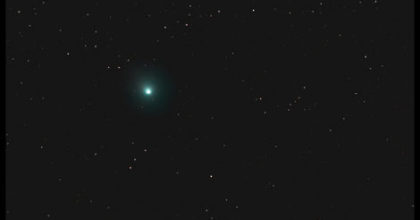
 )
)At the time of the first Christmas, the magi looked to the heavens for signs about their life on Earth. And they were not disappointed; the journey they undertook because of what they saw in those heavens enabled them to participate in one of the most significant events in human history. To us, their intracontinental, purely terrestrial trip might seem trivial, but they likely felt they were traversing a sizable portion of the world. So I wonder if those magi could have conceived of the heavens themselves as a destination rather than a navigational aid, and what it would take to reach them.
Visiting other stars is still a remote possibility in the distant future, but for us it is at least something we can imagine. We have already been to the moon and sent probes and landers to other planets. For just the second time, a human artifact has exited our solar system, taking the first steps into interstellar space. Even when something rare and stunning like a green comet passes through our neighborhood, few of us see that as a sign from the heavens. A new object in the sky is a potential new place to go out there, not a marker of an event down here.
For some of us, that means our hope is out there as well. This planet has finite room, finite resources. The grandest ambitions of the human race require always more, and so we imagine living out among the stars, or at the very least elsewhere in the solar system. Perhaps orbiting some other star out there is a planet with an ecosystem just waiting for us to move in, but more likely substantial effort on our part will be necessary to make any potential new home even remotely habitable. That is certainly the case for Mars. Consider all that it took to keep just a few humans alive for a short mission in The Martian. And as a fictional scenario, it was almost certainly optimistic. For instance, the soil chemistry on Mars likely wouldn’t support potato plants with just the fertilization depicted; more substantial reconditioning will probably be necessary. A Mars colony would represent a monumental new creation of our own making if it were to ever be successful.
I enjoy dreaming of life out there as much as the next person; I’d be thrilled if Star Trek turned out to be a prescient vision of our future. Yet even if my wildest fantasies were to be realized, we would still be wise not to put all our hope in space travel. Not every answer can be found out there. The laws of thermodynamics still apply in space. The stars themselves groan along with the rest of creation; in time, they will burn out and cease to shine. So as we dream and perhaps one day actually venture out to other planets & stars and create new wonders along the way, we should remember that the heavens also still remain a sign of the new creation to come. The seemingly limitless abundance of space is just a foretaste of the expansive abundance God can provide. As fantastic as the voyages may be that potentially await us here in this universe, the world the Christmas star points all of us towards promises to be more fantastic still.
Andy has worn many hats in his life. He knows this is a dreadfully clichéd notion, but since it is also literally true he uses it anyway. Among his current metaphorical hats: husband of one wife, father of two teenagers, reader of science fiction and science fact, enthusiast of contemporary symphonic music, and chief science officer. Previous metaphorical hats include: comp bio postdoc, molecular biology grad student, InterVarsity chapter president (that one came with a literal hat), music store clerk, house painter, and mosquito trapper. Among his more unique literal hats: British bobby, captain’s hats (of varying levels of authenticity) of several specific vessels, a deerstalker from 221B Baker St, and a railroad engineer’s cap. His monthly Science in Review is drawn from his weekly Science Corner posts — Wednesdays, 8am (Eastern) on the Emerging Scholars Network Blog. His book Faith across the Multiverse is available from Hendrickson.

Leave a Reply